History of the church and monastery of the Franciscans in Warsaw
6. XI. 1645 – King Władysław IV – at the request of his court capellmeister, an Italian Franciscan father Vincent Scopito de Valentia, and in recognition of his merits – gives his consent to the creation of the Franciscan monastery in Warsaw.
10.V. 1646 – Andrzej Szołdrski, the Bishop of Poznan and the apostolic legate Jan de Torres consecrate the cornerstone and corner of Wójtowska and Przyrynek streets. Soon the monks turn this square into a bigger one at Trakt Zakroczymski.
3. X. 1646 – Consecration of a wooden, small church dedicated to St. Franciszek Seraficki ( nothing certain is known about its external shape).
3. II. 1657 – During the Swedish occupation of the city, the original church as well as the monastery buildings were completely devastated by fire caused by an arsonist.
1662 – 1663 – Construction of the second temple (also of wood) with five altars. The following year, the burghers of Warsaw offer purchased paintings: stigmatization of St. St. Francis, Antony and of Our Lady. The new church quickly turns out to be too small for an increasing number of the faithful.
1663 – 65 – Construction of a new, one-storey wooden monastery – dimensions 9 x 18 m.
2. VII. 1679 – Laying the foundation stone for the construction of a new church. The beginning of collecting the necessary materials and inviting an Italian architect Giovanni Battista Ceroni to work out the plans of the building. Its construction started a decade later, lasted several decades and was repeatedly interrupted due to lack of funds, epidemics haunting the city and ongoing wars.
The following stages can be distinguished:
1690 – 97 – Overseen by Giovanni Ceroni the construction of the chancel and the adjacent two chapels: the one of Our Lady and the other of St. Antony (present sacristy). The generous donors were Adam Kotowski, the lord of Wyszogród and the king Jan III Sobieski (the then Superior of the monastery, Father Rafał Grabia, was his court theologian and confessor).
1700 – 04 – Laying the foundations under the pillars and putting the walls together. The further construction works cease. The cause of that situation is the poverty, the plague in the years 1708 – 12, devastating the city (in the monastery remained only one religious survivor) and invasion of Swedish troops.’
1713 – 17– Construction of the transept, overseen by Joseph Fontana. The works restart due to the resourcefulness and determination of the then Guardian, Father Gabriel Welisewicz. Thanks to him at that time began the construction of a new brick monastery of the present size.
1728 – 37 – Completion of the church corps by Joseph Fontana and his son Jacob. The works are continued thanks to the generous donation of the Governor of Cracow, Prince Jerzy Lubomirski, as evidenced by a commemorative epitaph with his coat of arms, seen on the front of the temple, dated MDCCXXXII (1732).
1730 – 50 – Execution of laborious decorations on the subtle rococo façade of the temple by Jacob Fontana.
1733 – Completion of a brick, three-winged monastery, adjacent to the church and forming a closed quadrangle with its internal courtyard. The work is overseen by an Italian architect Antonio Solari. The great contribution in this work belongs to the long-time Guardian, Father Gabriel Welisewicz (+ 23 March 1738).
29. IX. 1737 – Ceremonial consecration of the church dedicated to St. Franciszek Seraficki, by Stanisław Hozjusz, the Bishop of Poznan. There comes the period of rich and varied pastoral and cultural activities of the Franciscans in Warsaw.
1741 – Installation of small 8-voice church organ in the chapel of Our Lady.
1746 – Bringing to Warsaw – thanks to the efforts of Father Michal Halkiewicz – the relics of St. Vitalis (aka Clement), a Roman martyr from the beginning of the fourth century.
1753 – 54 – From the side of Franciszkańska Street the new wing of the monastery for novitiate as well as the Chapel of St. Vitalis, the martyr (project by Antonio Solari) were built.
19.IX.1754 – Ceremonial transfer of the relics of St. Vitalis (aka Clement) to the new chapel, in the presence of the queen, the clergy, the senators, the deputies, the crown guard and the people of the capital city.
1755 – Installation of a new church organ (14-voice one, with two pedal keyboards and 3-voice choir organ with three bellows), by Wawrzyniec Zodorski, an organ-builder.
1775 – Reconstruction of the temple choir – extension of the side parts up to the line of pillars (design by the architect Bonaventure Solari).
1778 – Reconstruction of the Rococo façade of the church into the classicist one (Giuseppe Boretti’s project).
1802 – A decree of the Prussian king referring to the suppression of the monastery and to the exile of the monks to the monastery in Warka. Napoleonic wars and the weakening of the Prussian influence in the capital made the Franciscans manage to stay – they lost only a part of the monastery from the side of Franciszkańska Street 2 (the so-called novitiate), which was rebuilt to prison.
1817 – 19 – Removal of an existing ornamental rococo fence from the front of the church, along with the cemetery inside.
1829 – Reconstruction and enlargement of the church organ.
1835 – In the part of the monastery called novitiate (from the side of Franciszkańska Street 2) was founded – by the efforts of Father Provincial Jakub Piasecki and with the permission of the Tsar of Russia – the Academy of the Clergy, the only one in the Congress Kingdom, which educated candidates for the priesthood (in 1865 the Academy moved to the larger post-Carmelite convent at Krakowskie Przedmiescie).
1842 – 45 – Renovation works of the temple carried out thanks to the means obtained from the tsar’s treasury (restoration of most altars, repainting of the interior).
1864 – Suppression of the whole monastery in retaliation for active support of the January Uprising. The monks are exiled for life to the Franciscan monastery in Kalisz.
The church was taken over by the diocese and then changed into a garrison church for the Catholics serving in the Tsarist army in the nearby Citadel. The monastery was taken over by the invaders, sold and adapted to various secular purposes.
1918 – 19 – At the invitation of Aleksander Kakowski, the Bishop of Warsaw, the Franciscans return to the capital after 55 years of absence. They only got back to the west wing of the monastery.
The interwar period is an intensive time of restoration and new equipment installation of the temple (assumption of electrical and heating systems, zinc sheet covering of the roof, building of new church organ and confessionals, renovation of altars, painting of the whole interior…) as well as a significant revival of pastoral work and cultural activities.
IX. 1939 – During the siege of Warsaw, German cannon bullets caused numerous damage in the temple (the transept and the altar of St. Antony suffered most).
VIII. 1944 – During the Warsaw Uprising the church and the monastery became a shelter for hundreds of refugees. The monks actively engage in spiritual and material help for insurrectionists and civilians. They run a field kitchen and an aid station. They serve as clergymen and paramedics in many places in the Old Town. As a result of the warfare, the church and the monastery are increasingly destroyed by enemy missiles.
30.VIII.1944 – In the bombing of the church by German air force Luftwaffe 40 people were killed in the basement. In the old part of the monastery from the side of Franciszkańska Street 2, which housed a shelter for about 300 old people expelled from Wielkopolska region, about 80 people died in this war action.
31.VIII.1944 – Takeover of the monastery by the Nazi troops. Franciscans and refugees are interned. The ruined church and convent become the object of looting and acts of vandalism. In the old house of the novitiate, the Germans burn alive nearly 40 infirm and wounded women and turn the building into ruins.
20.I.1945 – Return of the Franciscans to the capital. The following day, on the ruins, at the altar of St. Antoni of Padua, is celebrated the first Holy Mass in the left bank area of Warsaw.
1945 – 49 – Caring for the poorest, the Franciscans build a large barrack next to the monastery, where volunteers and Caritas provide daily charity for nearly half a thousand children and young people. After four years of fruitful service, the center is closed by communist authorities.
Since 1947 – The intensive rebuilding and retrofitting of the temple: installation of the new roof ceilings (1945-46), new chancel floors (1945, 1948), repair of both towers (1948), renovation of side altars (1945-63), renovation of church organ (1949, 1953), installation of bells (1961), renovation of the pulpit (1964-66), restoration of the main altar (1973-83), renovation of the elevation (1954, 2003, 2016), damp insulation (2004 – 2015), insulation of the roof ceilings (2010-2015) (2012-14), heating and lighting modification (2015-16), widening of the square in front of the church (2017).
Almost at the same time, takes place the reconstruction of the monastery, namely: the adaptation of the partly saved western wing (1945-46) to habitable conditions as well as the erection of the other two wings (1950-54).
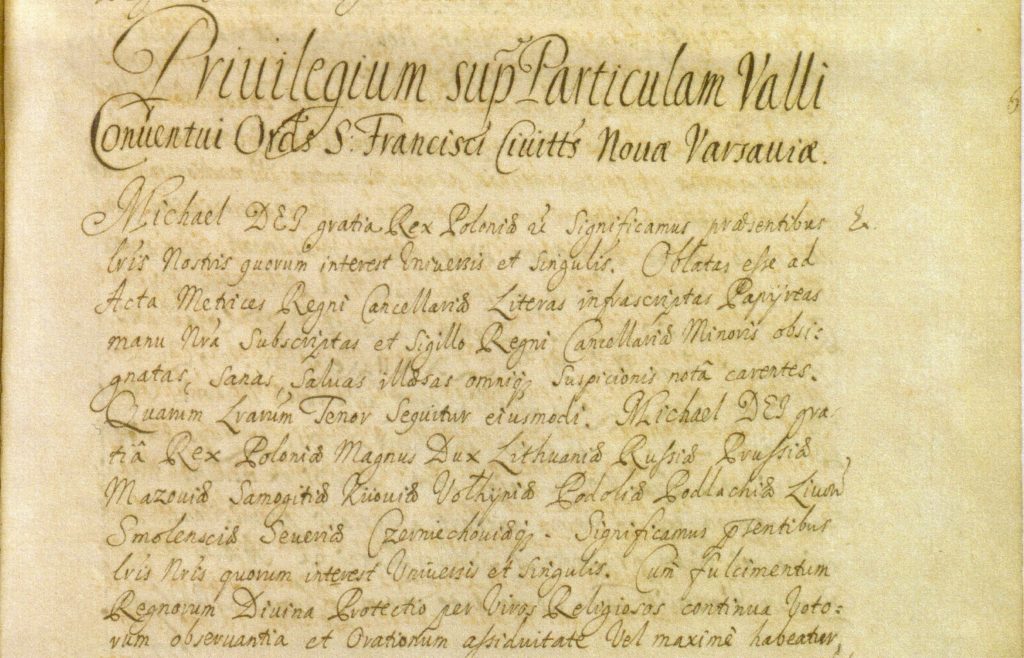
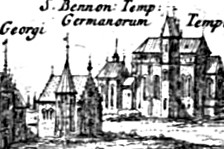
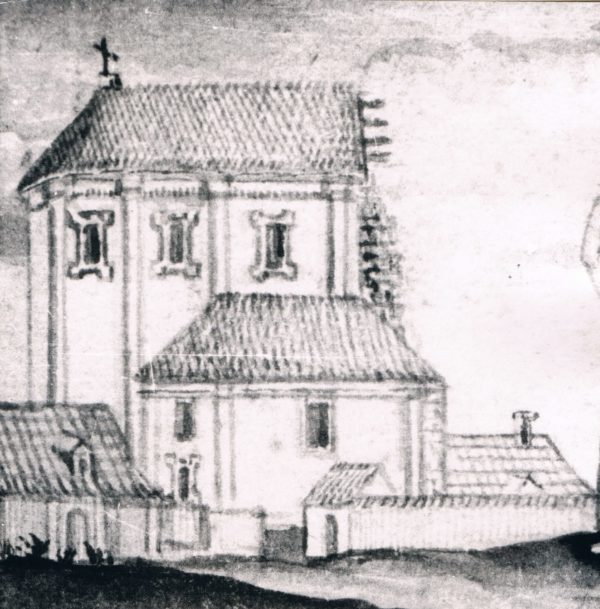
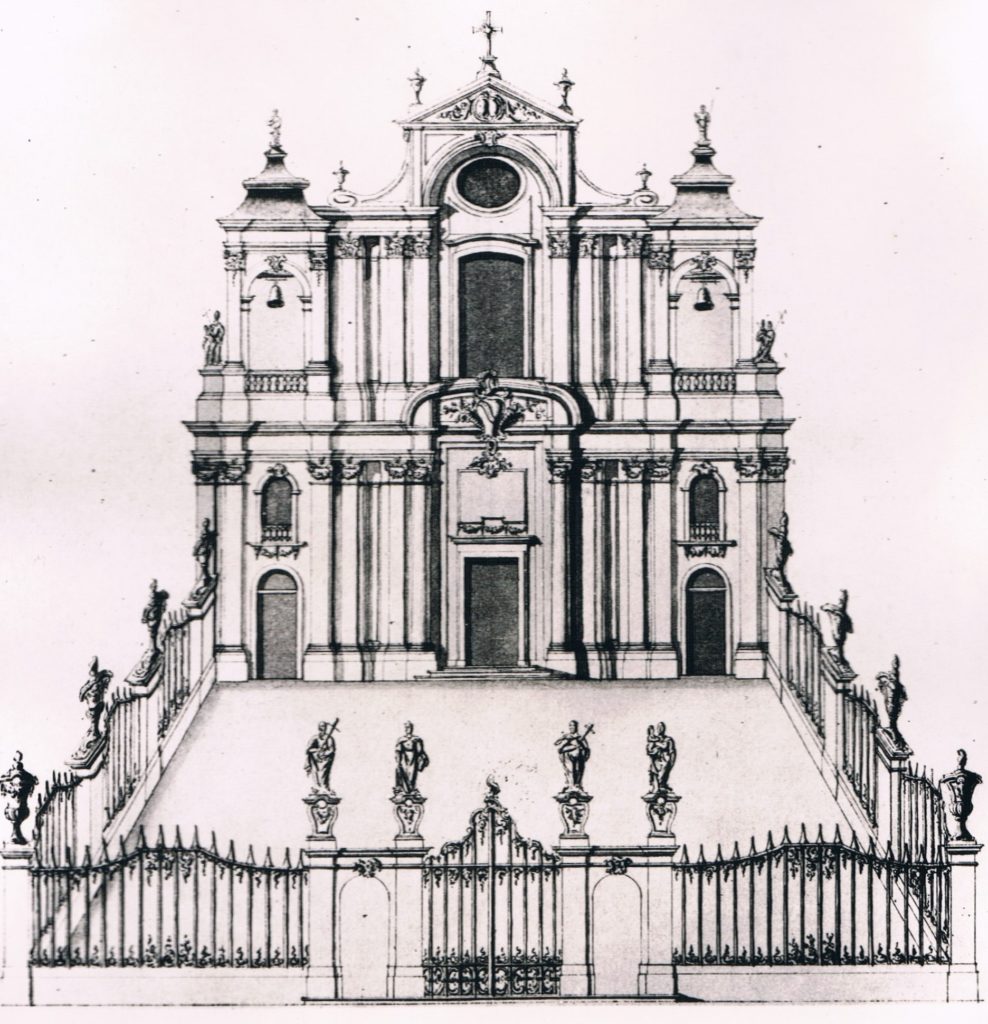
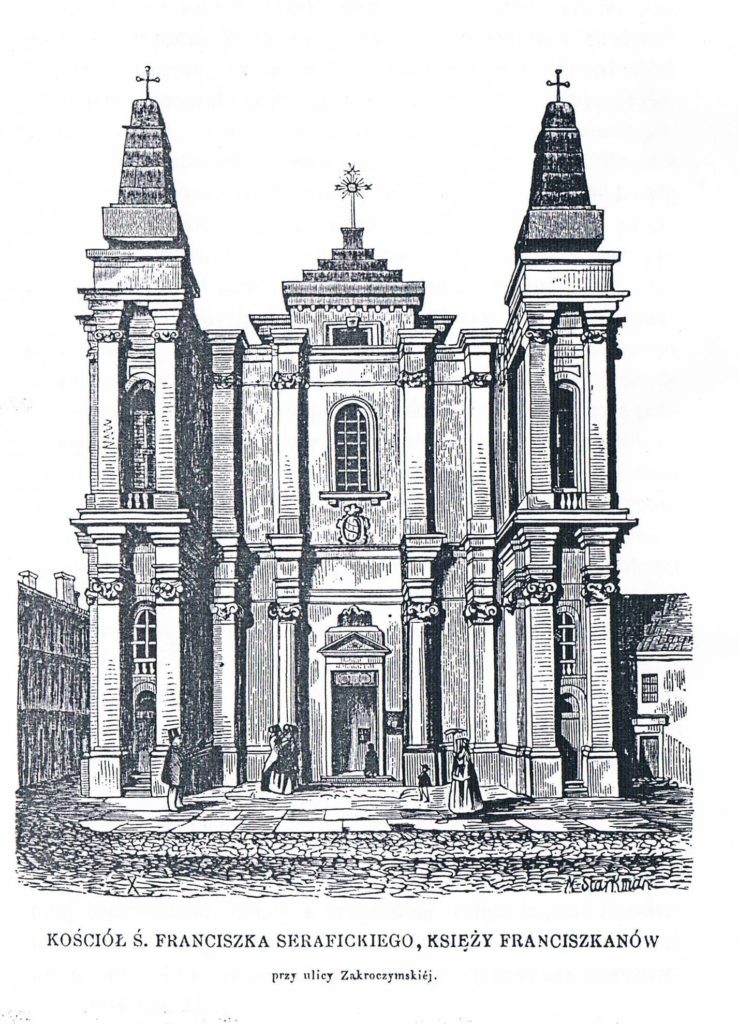
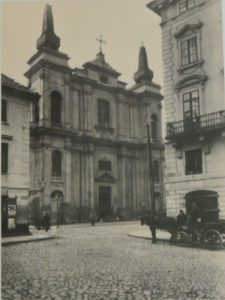
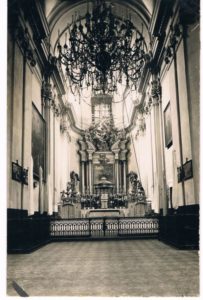
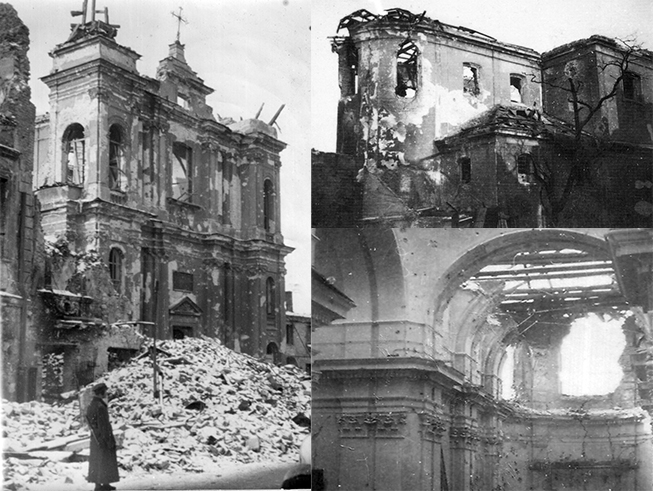
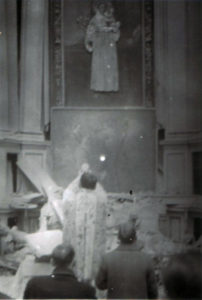
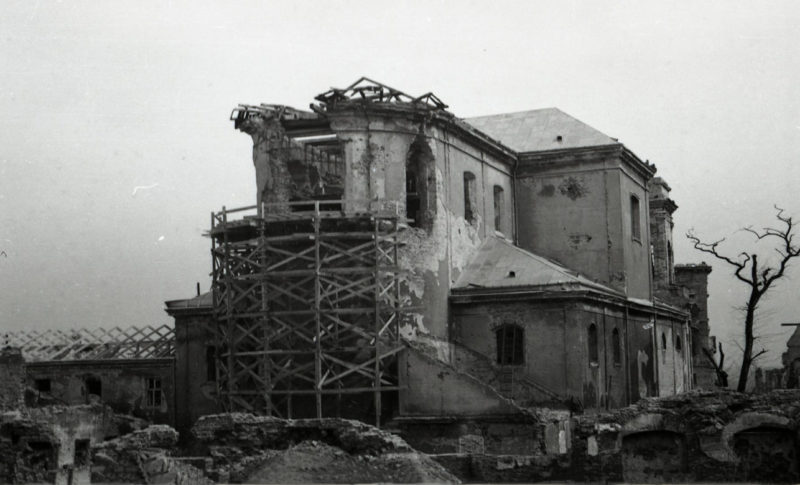
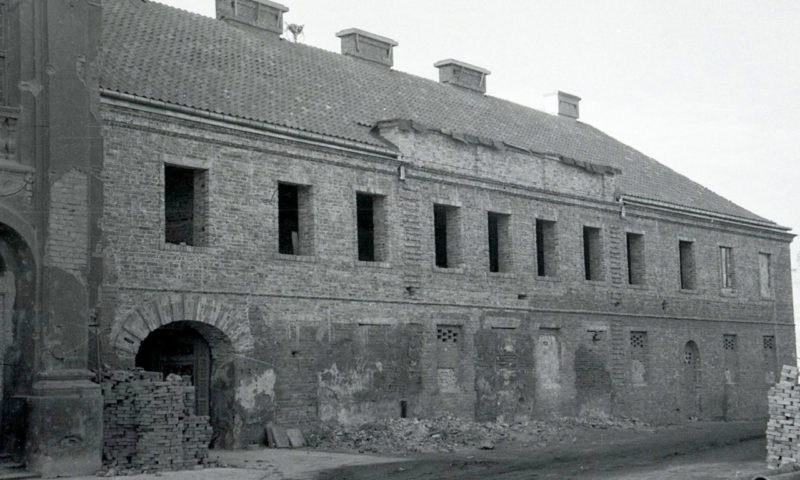
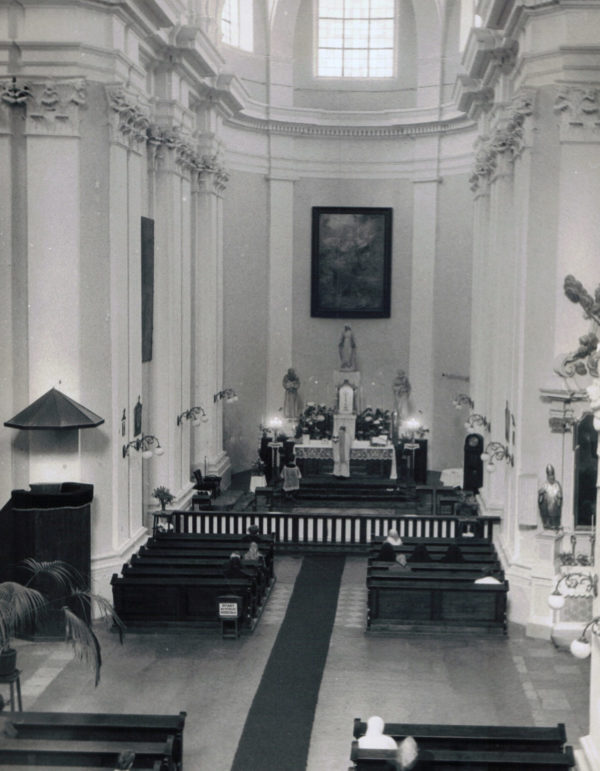
Renovation and restoration works of the entire post-war period continue all the time. Thanks to them, the temple regains its original glow.
